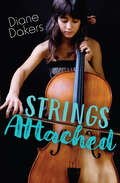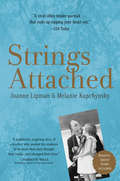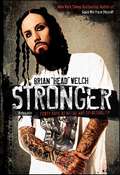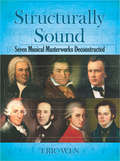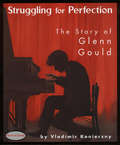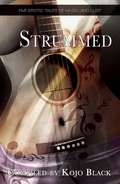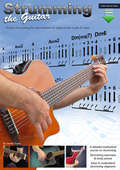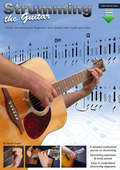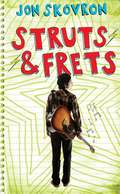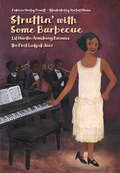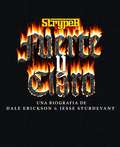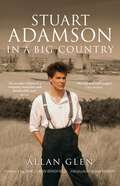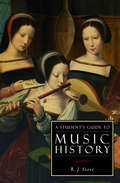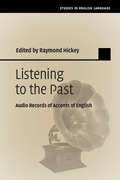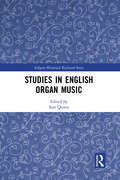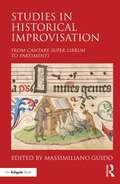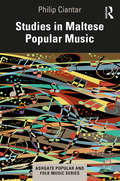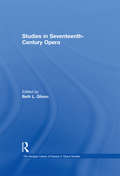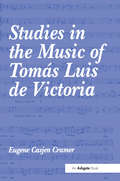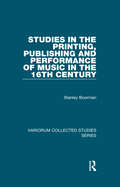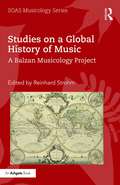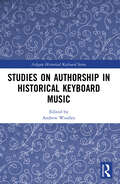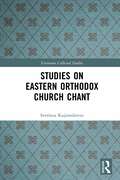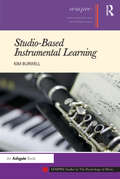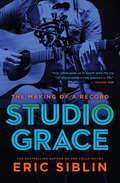- Table View
- List View
Strings Attached (Orca Limelights)
by Diane DakersBrielle and Tawni have played cello side by side in orchestras since they were nine years old. Brielle has always played second chair to Tawni’s first, and she's been happy with that arrangement. When Tawni is injured, Brielle suddenly finds herself principal cellist. Not only does that mean she'll be thrust into the spotlight, but it also means she is now leader of the cello section. Brielle is terrified. Is she good enough? Will the other musicians accept her? What if she screws up? Despite her fears, Brielle rises to the occasion. Her cello skills, and her leadership skills, improve as she grows into her new role. But just as Brielle is beginning to feel confident, Tawni returns. And she wants her job back. If Brielle steps down now, she'll lose her place in the spotlight. If she doesn't, her friendship could be in jeopardy.
Strings Attached: One Tough Teacher And The Art Of Perfection
by Joanne Lipman Melanie KupchynskyStrings Attached is a powerful memoir about resilience in the face of unspeakable tragedy, an inspiring and poignant tale of how one man transformed his own heartache into a legacy of joy for his students. His students knew Jerry Kupchynsky as "Mr. K"-the fierce Ukrainian-born music teacher who rehearsed them until their fingers almost bled and who made them better than they ever expected to be. Away from the classroom, though, life seemed to conspire against him at every turn. Strings Attached takes you on his remarkable journey, from his childhood on the run in Nazi Germany, to his life in America caring for his disabled wife while raising their two small daughters, to his search for his beloved younger daughter after she mysteriously disappeared-a search that would last for seven years. His unforgettable story is lyrically told in alternating chapters by two childhood friends who reconnected decades later: Melanie Kupchynsky, his daughter, and Joanne Lipman, a former student. Heartbreaking yet ultimately triumphant, Strings Attached is a testament to the astonishing power of hope-and a celebration of the profound impact one person can have on the lives of others.
Stronger: Forty Days of Metal and Spirituality
by Brian WelchThis 40-Day devotional from Brian “Head” Welch, former lead guitarist of Korn and the New York Times bestselling author of Save Me From Myself, is an intimate tour through the Bible passages that have meant the most to him on his trying journey from substance abuse to salvation. Save Me From Myself, Welch’s self-effacing story his against addiction and his reawakening to divine love, has made the metal band icon into a hero of Christian rock. Uncompromisingly honest about his demons, and equally fervent about his faith, Head and his impassioned devotional offer a uniquely voiced guiding light perfect for young Christians and rock music fans everywhere.
Structurally Sound: Seven Musical Masterworks Deconstructed (Dover Books on Music)
by Eric WenMusic theorist Eric Wen presents in-depth analyses of seven masterworks from the common-practice period of Western art music:Bach: Air from Orchestral Suite No. 3 in D, BWV 1068 Mendelssohn: Andante con moto tranquillo from Piano Trio No. 1 in D minor, Op. 49 Schubert: Nacht und Traüme, D. 827 Haydn: Adagio — Vivace assai from Symphony No. 94 in G, Hob. I:94 Mozart: Molto Allegro from Symphony No. 40 in G minor, K. 550 Beethoven: Marcia funebre: Adagio assai from Symphony No. 3 in E-flat, Op. 55 Brahms: Un poco presto e con sentimento from Violin Sonata No. 3 in D minor, Op. 108Wen employs the analytic approach developed by Heinrich Schenker, a method that uses musical notation to clarify and illuminate a work's structural hierarchies. Copiously illustrated with analytic musical examples that elucidate the tonal organization of each of the seven works, this study also explores aspects of form, rhythmic organization, and programmatic meaning. This volume will be of particular interest to musicologists and professional musicians, and it will also appeal to listeners keen to probe the rich complexities of these masterpieces.
Struggling for Perfection: The Story of Glenn Gould
by Vladimir KoniecznyStruggling for Perfection is the story of the famous pianist, an enigmatic figure who made some of the most acclaimed classical recordings of the last century. A former child prodigy and an unpredictable, passionate man, Glenn Gould was known as much for his eccentricities as his vast musical genius. After retiring prematurely from performing, Gould branched out into work in film and radio and helped bring classical music recording technology into a new age. He has became a national icon in Canada. Vladimir Konieczny delivers a sensitive and affectionate portrait of this imposing figure in music history. The book is illustrated with sketches and archival photos.
Strummed
by B. Z. Vukovina Amélie Hope Harper Eliot Percy Quirk Stella HarrisStrummed combines the two universally enjoyable elements of music and sex. Five new and talented authors come together to create a collection of the most melodious kink!
Strumming the Guitar: Guitar Strumming for Intermediate & Upward with Audio & Video (Strumming the Guitar #2)
by Gareth EvansStrumming the Guitar Book 2 is a detailed course for intermediate level and upward focusing solely on the subject of guitar strumming. This book goes beyond the basics, covering power chords, strumming in 3/4 time, barre chords, swing feel, early chord changes, using a capo to change key, using a capo to avoid barre chords, muted strums and 16th note strumming in 4/4 time and 6/8 time. Throughout the book as the difficulty level progresses, separate sections take on strumming alone, changing chords alone and coordinating chord changes while strumming, therefore maintaining a thorough approach with components broken down at every level. Guitar Strumming Techniques - Advice is given on how to fret and strum power chords, barre chords (major, minor and dominant 7th) and how to refer to the root note to find them, using a capo and muted strumming. All with purpose made diagrams and professionally hand drawn illustrations. Guitar Strumming Patterns - 158 different guitar strumming patterns that can be used throughout the book, all written with easy to understand, graphical, strumming diagrams. These include 70 strumming patterns in 4/4 time, 22 strumming patterns in 3/4 time, 20 muted strumming patterns, 24 sixteenth note strumming patterns in 6/8 time and 22 sixteenth note strumming patterns in 4/4 time. Chord Changes - Over 100 chords are used to facilitate what the book teaches about strumming, divided into fourteen groups of chord changes. From simpler chords such as A major to more advanced ones such as A7sus2/G and lots more inbetween. Strumming Exercises and Study Pieces - Every section includes strumming exercises that combine chord changes with strumming, each section concluding with a musical study piece using the skills learnt in styles of Grunge, UK Modern Alternative, Jig, Waltz, Pop, Swing Jazz, Blues, Pop Ballad and Power Ballad. There are 70+ strumming exercises and 15 musical study pieces, while more combinations can be found by selecting from the 158 given strumming patterns to use with them. Audio and Video - All exercises and musical study pieces are demonstrated with audio (downloadable 149 MB). All study pieces have a backing audio track for you to play over. Online videos (7 in total size of 90.8 MB) are also used to enhance explanations. Please Note: The eBook includes musical pieces so is not suitable for smaller screens.
Strumming the Guitar: Guitar Strumming for Beginners and Upward with Audio and Video (Strumming the Guitar #1)
by Gareth EvansStrumming the Guitar Book 1 is a detailed course for beginners and upward, focusing solely on the subject of guitar strumming. Separate sections take on strumming, changing chords and coordinating chord changes while strumming, therefore maintaining a thorough approach throughout with components broken down at every level. With this incremental method, this guitar strumming book enables beginners to absorb everything important from the start and progress consistently as the difficulty level increases. Guitar Strumming Techniques - Before anything else, the basics of strumming are covered from the ground up, assisted with professional hand drawn illustrations. Learn how to hold the plectrum for strumming, how to strum chords that require you to miss certain strings, pre-emptive chord changing, open strums and more.Guitar Strumming Patterns - 70 different guitar strumming patterns that can be used throughout the book, all written with easy to understand, graphical, strumming diagrams. Rhythmical Notation - Understand the common language of music by becoming familiar with rhythmical notation. Learn whole notes, half notes, quarter notes, eighth notes, their equivalent rests, dotted notes, ties and the basics of time signatures. All shown with clear charts and diagrams.Chord Changes - Seven groups of chord changes, made up almost entirely of open chords. The book starts with the easiest chord changes in which fretting finger locations can be shared and works up to more difficult chord changes where fretting fingers need to relocate in independent directions.Strumming Exercises and Study Pieces - Every section includes strumming exercises that combine chord changes with strumming, each section concluding with a musical study piece using the skills learnt in styles of Slow Pop, Spanish style, Grunge and Country Pop. In total there are 85 strumming exercises and 10 musical study pieces, while more combinations can be found by selecting from the 70 given strumming patterns to use with them.Audio and Video - All exercises and musical study pieces are demonstrated with audio (downloadable 154 MB). All study pieces have a backing track for you to play over. Online videos (21 in total size of 775 MB) are also used to enhance explanations.Please Note: The eBook includes musical pieces so is not suitable for smaller screens.
Struts and Frets
by Jon SkovronTold in a voice that's honest, urgent, and hilarious, "Struts and Frets" is a bright debut novel about forming a band, falling in love, and facing the truth.
Struttin' with Some Barbecue: Lil Hardin Armstrong Becomes the First Lady of Jazz
by Patricia Hruby PowellLil Hardin and her man, Louis Armstrong, were musical royalty--inventing a new kind of sound--makin' jazz. Believe it, baby!This is the true story of Lil Hardin Armstrong: pianist, composer, and bandleader in the early days of jazz. Ahead of her time, Lil made a career for herself--and for Louis Armstrong, her modest, unassuming husband. Louis might never have become the groundbreaking jazz player he was, if it hadn't been for Lil. Scat-inspired verse celebrates how Lil overcame race and gender barriers to become the first lady of the Chicago jazz scene."Brimming with a contagious love of jazz and its first lady, this work brings down the house"--Kirkus Reviews, STARRED review
Stryper: Fuerte y Claro
by Dale Erickson Jesse SturdevantEste libro relata toda la historia de esta legendaria banda de metal cristiano. Desde la infancia de los miembros, la época del Roxx Regime, su éxito en la radio y MTV, y los estadios llenos, hasta las triunfantes giras de reunión y las grabaciones, cubre casi todo lo que hay que saber sobre Stryper, y no sólo la palabrería. Preguntas como "¿Cómo evolucionó Stryper?" o "¿Qué ocurrió realmente durante el periodo de Against the Law?" tienen respuesta aquí. Las respuestas, derivadas de incontables horas de entrevistas, proceden directamente de los propios miembros de la banda y de muchas otras fuentes.
Stuart Adamson: In a Big Country
by Glen AllanA music journalist and fan examines the life and work of the Scottish guitarist, vocalist, and songwriter. The book that fans of the Skids, Big Country and the Raphaels have been waiting for—a critical perspective not only of Adamson&’s music and its wider cultural influence, but also the excesses of fame and how the music business really works. Stuart Adamson: In A Big Country tells the story of how a teenager who was raised in a small Fife village released his first single at 19, wrote three Top 40 albums in the next three years and was written off as a has-been at 23, but then went on to form a new band and sell more than 10 million records worldwide, touring with the Rolling Stones and David Bowie. Although Adamson was one of the most respected and popular figures in the music industry, his personal life was complex and ultimately tragic, ending with his alcohol-fueled suicide in a Hawaiian hotel in December, 2001.&“He was a massive, massive influence on me . . . Absolute genius.&” —James Dean Bradfield, Manic Street Preachers&“An overdue tribute to a visionary musician and honorable man.&” —Keith Cameron, Mojo&“Engaging journey through the peaks and troughs of an ultimately troubled life . . . Moving and well-judged.&” —Rob Hughes, The Word
A Student's Guide to Music History (ISI Guides to the Major Disciplines)
by R.J. Stove&“Delightfully sophisticated . . . the only music history that can be savored, muscatel in hand, in the green shade of a beach umbrella&” (John Simon, The Hudson Review). R. J. Stove&’s A Student&’s Guide to Music History is a concise account, written for the intelligent lay reader, of classical music&’s development from the early Middle Ages onwards. Beginning with a discussion of Hildegard von Bingen, a twelfth-century German nun and composer, and the origins of plainchant, Stove&’s narrative recounts the rise (and ever-increasing complexity) of harmony during the medieval world, the differences between secular and sacred music, the glories of the contrapuntal style, and the origins of opera. Stove then relates the achievements of the high baroque period, the very different idioms that prevailed during the late eighteenth century, and the emergence of Romanticism, with its emphasis upon the artist-hero. With the late nineteenth century came a growing emphasis on musical patriotism, writes Stove, especially in Spain, Hungary, Russia, Bohemia, Norway, Denmark, Finland, and the United States. A final section discusses the trends that have characterized music since 1945. Stove&’s guide also singles out eminent composers for special coverage, including Palestrina, Monteverdi, Handel, Bach, Haydn, Mozart, Beethoven, Schubert, Wagner, Verdi, Brahms, Debussy, Richard Strauss, Sibelius, and Messiaen. As a brief orientation to the history and contours of classical music, A Student&’s Guide to Music History is an unparalleled resource.
Studies in English Language: Listening to the Past
by Raymond HickeyAudio recordings of English are available from the first half of the twentieth century and thus complement the written data sources for the recent history of the language. This book is the first to bring together a team of globally recognised scholars to document and analyse these early recordings in a single volume. Looking at examples of regional varieties of English from England, Scotland, Ireland, the USA, Canada and other anglophone countries, the volume explores both standard and vernacular varieties, and demonstrates how accents of English have changed between the late nineteenth century and the present day. The socio-phonetic examinations of the recordings will be of interest to scholars of historical linguistics, the history of the English language, language variation and change, phonetics, and phonology.
Studies in English Organ Music (Ashgate Historical Keyboard Series)
by Iain QuinnStudies in English Organ Music is a collection of essays by expert authors that examines key areas of the repertoire in the history of organ music in England. The essays on repertoire are placed alongside supporting studies in organ building and liturgical practice in order to provide a comprehensive contextualization. An analysis of the symbiotic relationship between the organ, liturgy, and composers reveals how the repertoire has been shaped by these complementary areas and developed through history. This volume is the first collection of specialist studies related to the field of English organ music.
Studies in Historical Improvisation: From Cantare super Librum to Partimenti
by Massimiliano GuidoIn recent years, scholars and musicians have become increasingly interested in the revival of musical improvisation as it was known in the Renaissance and Baroque periods. This historically informed practice is now supplanting the late Romantic view of improvised music as a rhapsodic endeavour—a musical blossoming out of the capricious genius of the player—that dominated throughout the twentieth century. In the Renaissance and Baroque eras, composing in the mind (alla mente) had an important didactic function. For several categories of musicians, the teaching of counterpoint happened almost entirely through practice on their own instruments. This volume offers the first systematic exploration of the close relationship among improvisation, music theory, and practical musicianship from late Renaissance into the Baroque era. It is not a historical survey per se, but rather aims to re-establish the importance of such a combination as a pedagogical tool for a better understanding of the musical idioms of these periods. The authors are concerned with the transferral of historical practices to the modern classroom, discussing new ways of revitalising the study and appreciation of early music. The relevance and utility of such an improvisation-based approach also changes our understanding of the balance between theoretical and practical sources in the primary literature, as well as the concept of music theory itself. Alongside a word-centred theoretical tradition, in which rules are described in verbiage and enriched by musical examples, we are rediscovering the importance of a music-centred tradition, especially in Spain and Italy, where the music stands alone and the learner must distil the rules by learning and playing the music. Throughout its various sections, the volume explores the path of improvisation from theory to practice and back again.
Studies in Maltese Popular Music (Ashgate Popular and Folk Music Series)
by Philip CiantarThis book examines the diverse facets of popular music in Malta, paying special attention to għana (Malta’s folk song), the wind band tradition, and modern popular music. Ciantar provides intriguing discussions and examples of how popular music on this small Mediterranean island country interacts with other aspects of the island’s life and culture such as language, religion, history, customs, and politics. Through a series of ethnographic vignettes, the book explores the music as it takes place in bars, at festivals, and during village celebrations, and considers how it is talked about in the local press, at group gatherings, and on social media. The ethnography adopted here is that of a native musician and ethnomusicologist and therefore marries the author’s memories with ongoing observations and their evaluation.
Studies in Seventeenth-Century Opera
by BethL. GlixonThe past four decades have seen an explosion in research regarding seventeenth-century opera. In addition to investigations of extant scores and librettos, scholars have dealt with the associated areas of dance and scenery, as well as newer disciplines such as studies of patronage, gender, and semiotics. While most of the essays in the volume pertain to Italian opera, others concern opera production in France, England, Spain and the Germanic countries.
Studies in the Music of Tomás Luis de Victoria
by EugeneCasjen CramerRepresenting nearly thirty years of research by one of the leading scholars in the field, this series of in-depth studies examines selected aspects of the music of the great Spanish composer in the late Renaissance, Tom Luis de Victoria. Presenting new insights into both the musical style and language and the compositional procedure of this contemporary of Palestrina, Lasso and Byrd, Eugene Cramer illuminates the extent to which Victoria's compositions are musically related. The book reveals that the falsobordone or fabord layed a much larger role in Victoria's music than has previously been thought. Cramer also demonstrates that Victoria's parody or imitation technique, especially in respect to his Masses of 1592, extended the parameters that are generally thought to be characteristic of works of this type. Of special interest is the discussion of thirty-eight works, including thirty-four psalm settings that are attributed to Victoria in extant manuscript sources. Extensively illustrated with over 130 musical examples, these studies will not only interest the serious student of sacred music, but also the performer, both the singer and the conductor alike.
Studies in the Printing, Publishing and Performance of Music in the 16th Century (Variorum Collected Studies #815)
by Stanley BoormanThe emergence of music printing and publishing in the early 16th century radically changed how music was circulated, and how the musical source (printed or manuscript) was perceived, and used in performance. This series of close studies of the structure and content of 16th-century and early 17th-century editions (and some manuscripts) of music draws conclusions in a number of areas - printing techniques for music; the habits of different type-setters and scribes, and their view of performing practice; publishers' approaches to the musical market and its abilities and interests; apparent changes of plan in preparing editions; questions of authorship; evidence in editions and manuscripts for interpreting different levels of notation; ways in which scribes could influence performers' decisions, and others by which composers could exploit unusual sonorities.
Studies on a Global History of Music: A Balzan Musicology Project (SOAS Musicology Series)
by Reinhard StrohmThe idea of a global history of music may be traced back to the Enlightenment, and today, the question of a conceptual framework for a history of music that pays due attention to global relationships in music is often raised. But how might a historical interpretation of those relationships proceed? How should it position, or justify, itself? What would 'Western music' look like in an account of music history that aspires to be truly global? The studies presented in this volume aim to promote post-European historical thinking. They are based on the idea that a global history of music cannot be one single, hegemonic history. They rather explore the paradigms and terminologies that might describe a history of many different voices. The chapters address historical practices and interpretations of music in different parts of the world, from Japan to Argentina and from Mexico to India. Many of these narratives are about relations between these cultures and the Western tradition; several also consider socio-political and historical circumstances that have affected music in the various regions. The book addresses aspects that Western musical historiography has tended to neglect even when looking at its own culture: performance, dance, nostalgia, topicality, enlightenment, the relationships between traditional, classical, and pop musics, and the regards croisés between European, Asian, or Latin American interpretations of each other’s musical traditions. These studies have been derived from the Balzan Musicology Project Towards a Global History of Music (2013–2016), which was funded by the International Balzan Foundation through the award of the Balzan Prize in Musicology to the editor, and designed by music historians and ethnomusicologists together. A global history of music may never be written in its entirety, but will rather be realised through interaction, practice, and discussion, in all parts of the world.
Studies on Authorship in Historical Keyboard Music (Ashgate Historical Keyboard Series)
by Andrew WoolleyAuthorship is a pertinent issue for historical musicology and musicians more widely, and some controversies concerned with major figures have even reached wider consciousness. Scholars have clarified some of the issues at stake in recent decades, such as the places of borrowing and arranging in the creative process and the wider cultural significance of these practices. The discovery of new sources and methodologies has also opened up opportunities for reassessing specific authorship problems. Drawing upon this wider musicological literature as well as insights from other disciplines, such as intellectual history and book history, this book aims to build on what has already been achieved by focussing on keyboard music. The nine chapters cover case studies of authorship problems, the socioeconomic conditions of music publishing, the contributions of composers, arrangers, copyists and music publishers in creating notated keyboard compositions, the functions of attribution and ascription, and how the contexts in which notated pieces were used affected concepts of authorship at different times and places.
Studies on Eastern Orthodox Church Chant (Variorum Collected Studies)
by Svetlana KujumdzievaThis book focuses on the compilation of the different practices of Eastern Orthodox Chant, looking at the subject through various languages, practices, and liturgical books and letters. The subject of this book is also analysed through newly found, unique material, to provide the entire history of Eastern Orthodox Chant, from the ninth to the nineteenth centuries and approached through a number of different disciplines. The book consists of sixteen topics, grouped in four parts: Studies on Genre, Studies on Liturgical Books, Studies on Distinguished Men of Letters, and Studies on Bulgarian Orthodox Church Chant. The aim of the book is to present the Eastern chant as a phase in the evolution of Mediterranean art, which is the cradle of Graeco-Roman heritage. This complex study brings in a variety of sources to show the purpose of Eastern Orthodox Chant as strengthening the Christian faith during the Middle Ages and the revival of Balkan nationalism in the nineteenth century. This book will appeal to students and scholars alike, interested in liturgical musical books, liturgy, and chant repertory. Likewise, it will be of interest to those engaged in medieval and early modern history, music, and culture.
Studio-Based Instrumental Learning (SEMPRE Studies in The Psychology of Music)
by Kim BurwellIn Studio-Based Instrumental Learning, Kim Burwell investigates the nature of lesson interactions in instrumental teaching and learning. Studio lesson activity is represented as a private interaction, dealing with skill acquisition and reflecting a tradition based in apprenticeship, as well as the personal attributes and intentions of participants. The varied and particular nature of such interaction does not always lend itself well to observation or - when observed - to easy interpretation. This presents particular problems for practitioners wishing to share aspects of professional knowledge, and for researchers seeking to explain the practice. Focusing on a single case study of two clarinet lessons, Burwell uses video observations and interviews to analyse collaborative lesson activity, through the 'rich transcription' of performance, verbal and nonverbal behaviours. The foregrounded lesson interactions are also contextualised by the background consideration of social, cultural and institutional frameworks. The research is aimed a helping to create a framework that can support reflection among practitioners as they continually develop their work, not only experientially - through the tradition of 'vertical transmission' from one musician to another - but collaboratively, through the 'horizontal' sharing of good practice.
Studio Grace: The Making of a Record
by Eric SiblinWith a dozen original songs percolating in his head, bestselling author Eric Siblin had two chance encounters in the same month: one with a real estate agent named Jo, a talented singer with pop star dreams; and the other with a college acquaintance named Morey, a fiery guitarist, record exec turned digital music producer, and manager of his teenage daughter’s burgeoning singing career. These two serendipitous events mark the start of a musical odyssey.In Studio Grace, Eric Siblin chronicles the twelve-month realization of a long-held dream: recording an album of original material. To get there he plunges into the joyful and painful heart of songcraft, grappling with elusive verses and choruses until they are ready for recording. Siblin’s songs are captured in three very different studios reflecting the evolution of sound recording: a tiny basement studio run by a wedding band drummer; the famed Hotel2Tango analogue studio, where a former producer of Arcade Fire connects Siblin with hipster musicians; and the mansion attic where his new friend Morey creates songs on a laptop using the latest in digital technology and the global distribution network that is YouTube.Published to coincide with the release of the album of the same name, Studio Grace is an entertaining and demystifying behind-the-scenes look at the making of a record filled with songs about love gained and love lost, about modern identity theft and ancient battlegrounds, about life and death, fleshed out by a host of eclectic characters, from ambitious young singers to veteran session musicians and unknown engineers to high-profile producers — all of whom are pursuing the multi-layered dream of a four-minute pop song.
